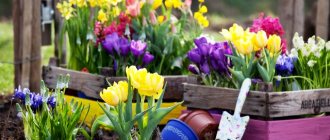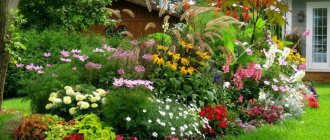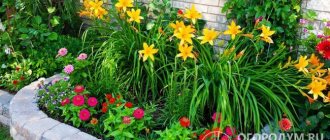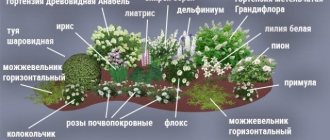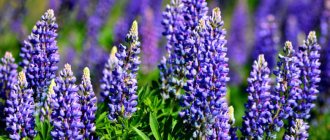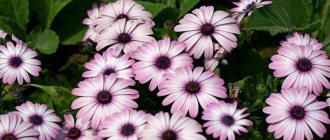Perennials are the most species-rich group of plants used in landscaping public and private areas. A variety of shapes, colors of single flowers and inflorescences, decorative leaves, a long life span - these are not all their advantages! By choosing perennial flowers with different flowering periods for your flowerbed, you can create amazing beauty that does not fade from early spring to late autumn.
Spring bulbs have long since faded and hid in the ground until the next season, summer flowers delight with a riot of colors, autumn flowers are waiting in the wings
Variety of flower beds
Before planting flowers, you need to decide on the place where they will grow. Previously, old car tires were widely used as flower beds, and some summer residents used ordinary beds without unnecessary finishing items instead of flower beds.
Today it is fashionable to plant flowers in various flowerpots and unusual flower beds. The main condition is their correct location and compatibility with each other.
Fast-growing trees for the garden
In landscaping a suburban area, you can use maples, birches and other tree species, but most often they are planted outside the fence. Typically, other crops are used within the land plot: ornamental, fruit, coniferous, medium and low-growing plants.
Deciduous decorative
Trees with an unusual crown shape and non-standard leaf color look beautiful on an open lawn. They are planted in small groups, singly, or as a background for flower beds.
Beautiful trees for the garden:
- Red maple Red Sanset – deep red leaves;
- False sycamore maple Purpurea - the underside of the leaf blade is burgundy in color, and the upper side is green;
- Ash-leaved maple “Flamingo” - newly opened leaves have a pink tint, later they become variegated;
- Norway maple Drummondii with variegated foliage;
- Tomentose linden Silver Globe - has spectacular silvery foliage;
- White poplar Nivea – the underside of the leaf blade is snow-white, when gusts of wind the crown shimmers with silver;
- Scandinavian mountain ash Magnifica - leaves are silvery-pubescent, ripen in the fall and bright red-orange clusters of berries remain on the branches for a long time.
Decorative deciduous trees are planted in the most visible places: near the gazebo, near the terrace, in the center of a flower arrangement, near an artificial pond. The place should be open or with light, openwork shade at midday. In dense shade, beautifully colored leaves lose color, and with it their elegance.
Coniferous fast-growing
Compared to deciduous trees, conifers grow much slower, but among them there are leaders. Large trees give the greatest increase in growth, and the first place is occupied by larch, Siberian and European.
Under favorable conditions, they grow 1 m per year. This is the only coniferous plant that sheds its needles for the winter: in the fall they turn yellow and fall off with the onset of frost. In winter, the bare branches of larch are not a very attractive sight, so it is not as often used in landscape design as other representatives of conifers.
Types of flower beds
Flowerbeds are the most common and accessible type. It has various geometric and shaped shapes. They are made from a variety of materials, from tires or pieces of building materials to stumps or unusual pots and vases.
Mixborders are a small area with different flowering plants that differ from each other in height and flowering time. Usually located near barriers and fences.
Lawns are a ready-made mixture of wildflowers and grass. Due to its natural beauty, it resembles a flower lawn in the lap of nature. Meadow flowers go well together: daisies, cornflowers, clover, mallow.
Arches - a metal or wooden structure serves as a base, next to which climbing plants are planted: morning glory, ivy, virgin grapes.
Rabatki are flower strips placed along paths or along the perimeter of a building. Low annuals are used as decoration: marigolds, marigolds, petunias.
Lemongrass
A small garden can be used not only decoratively, but also practically. For example, make a vegetable garden. And to make it all look interesting and harmonious, you can plant plants that bear fruit and look interesting.
One of these is lemongrass. At first glance, it is not even clear whether it is a flower or cereals.
Unpretentious flowers
When choosing varieties of a particular flower, you should rely on the basic rule - give preference to flowers that do not require care. The good thing about a country flower is that it is unpretentious.
It is not known how long the owner will be absent from the dacha. Flowers that require daily care, watering, and protection from pests quickly lose their beauty.
The once graceful flower garden will turn into a dull, unkempt area with weeds. Therefore, flowers for the garden should bloom profusely and require minimal care.
Standard roses
What is a garden without times? That's right, none. But for a small area it is worth choosing varieties of flowers that are not so spreading, for example, bush flowers. In our case, standard roses are suitable. They are somewhat similar to small tree seedlings with a hanging crown, on which large buds grow in a chaotic manner.
To decorate the garden, even one such tree planted in the center of the entire composition is enough.
Perennials or annuals?
Beginning summer residents often face this question. Annuals are considered ideal because of their instant and long flowering. The buds bloom 1-2 months after planting and continue to bloom until the first autumn frosts.
Perennials are distinguished by their short flowering time: from several weeks to two months. But they are loved for the beauty that they provide to their owners for many years and do not require special care.
Both perennial and annual flowers are used for landscape design.
- Indoor ventilation
Choosing grass for the lawn
Deutzia is blooming - summer is coming
Types of perennials
Among the abundance of perennial plants, bulbous varieties can be distinguished. Due to their unpretentiousness, they remain the main attributes of the garden for a long time. It is worth highlighting the most popular favorites of country gardeners.
Crocus is the first spring flower to appear in early spring. The buds appear simultaneously with the leaves. It blooms for a week, then goes dormant again. Not susceptible to diseases and does not require feeding.
Tulips are the most common bulbous flowers. They come in a variety of colors. The flowering period is no more than two weeks. The main enemy of the tulip is fungus, so before planting it must be treated with antifungal agents.
Daffodils are the second most popular perennial in the garden. Grows in one place for many years. Prefers moist, slightly shaded soil.
Iris - in recent years, the popularity of this flower has subsided. But many summer residents continue to plant it for the sake of its sweet aroma and rapid reproduction throughout the site.
Hyacinths, on the contrary, are gaining a fashionable trend in summer cottages. They are among the first to bloom and delight the eye with their bright blue, purple and white inflorescences.
Planting trees on the siteKerria or Keria: photo and description of the shrub, rules and subtleties of growing a plant with yellow flowers
Ornamental shrubs in landscape design blooming in autumn
Gladioli are flowers that bloom on the eve of the first of September. Favorite bouquet of teachers. The plant reproduces using bulbs and requires fertilizing. For the winter, gladioli bulbs are dug up and stored underground until spring.
Lilies are royal flowers that occupy a place of honor on the site. Differs in a variety of varieties, colors and flowering periods.
In addition to the described bulbous varieties, there are other types of perennial flowers. The most unpretentious of them:
- peonies;
- yarrow;
- phlox;
- dahlias;
- lychnis;
- clematis.
These plants bloom at different periods, which allows you to change the garden design several times during the season.
Perennial garden favorites
At all times, roses have delighted connoisseurs of flowering crops. Original buds adorn the tops of spreading bushes with prickly stems. They exude a unique aroma. They amaze with their variety of tones and long flowering period. Biologists classify roses into 9 main groups. Let's look briefly at each of them.
Park varieties of roses
The group combines decorative types of rose hips and roses of ancient origin. Flowers are used to decorate park areas. They look wonderful both in single and group plantings. They bloom at the end of spring and delight the eye with fragrant buds for a long time. Decorative varieties have buds with a diameter of about 10 cm. They are collected in small bouquets of 4-6 pieces. The leaf blades are usually leathery and slightly wrinkled. The maximum height of rose bushes reaches 2 m. Popular varieties: Ritausma, Grotendorst.
Repairers
Roses are tall shrubs.
Large terry buds, colored in the following colors, bloom on them twice a season:
- red;
- pink;
- snow-white;
- yellow;
- beige.
Roses miraculously withstand harsh winters if they are carefully covered with special devices.
Famous hybrids are grown in dachas: Georg Arends, Hugh Dixon, Paul Neuron, Georg Dixon.
Choosing flowers for the garden - tea roses
Hybrid tea roses were obtained through selection. In the middle regions they bloom at the end of June and do not stop sending out buds until late autumn. The bushes grow up to 150 cm. The buds have a terry structure and a variety of colors. Famous varieties: Athena, Angelique, Gloria Dei, Limbo, Sonia.
Polyanthaceae
The plant is a low bush strewn with flowers. The buds are collected in bouquets of 6 pieces. Petals can be either simple or double. Gardeners grow polyanthus roses in group plantings. In the northern regions they need reliable shelter. Low-growing varieties take root well in large containers.
Floribunda
Roses are profusely flowering plants that continuously decorate the bush from July to November. The buds are either simple or double, which are collected in inflorescences of several pieces. Famous varieties: Iceberg, Diadem, Nicole, Nicolo Paganini, Frisia.
Miniature
The original low-growing bushes grow to about 45 cm. During the flowering period, they are strewn with many double roses, painted in various shades. Some specimens are grown indoors, where they bloom all year round. Miniature roses are used for arranging rocky hills and rock gardens. The most popular types: Masquerade, Hummingbird, Mandarin.
Ground cover
The group consists of creeping shrubs. Dense foliage grows on long shoots. Their length reaches 4 m. Depending on the variety, the buds are simple or double. Used to decorate slopes and low walls. Famous varieties: Besi, Ondela, Snow Ballet, Fairy.
Flowers in the country - climbing roses
Roses are distinguished by many small buds that form lush bouquets. They appear during the flowering period on long creeping stems. This feature allows you to use the plant to decorate pergolas or entrance arches.
Original varieties are in demand:
- Dorothy Perkins;
- Excelsa;
- New Dawn;
- Flamentanz.
Shrubs (shrubs)
The group includes tall and powerful flowering bushes. In due time, graceful roses appear on them. They bloom once per season, but for a long period. The plant is resistant to temperature changes and unfavorable climatic conditions. Gardeners appreciate hybrid varieties: Mishka, Charlotte, Rococo, Abraham Darby.


